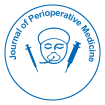
Journal of Perioperative Medicine
Open Access
ISSN: 2684-1290

ISSN: 2684-1290
Perspective - (2025)Volume 8, Issue 2
Perioperative care encompasses a continuum of healthcare services provided to patients before, during and after surgical procedures. It plays a pivotal role in optimizing patient outcomes, promoting recovery and minimizing complications. In this comprehensive guide, we explore the principles, components and best practices of perioperative care, aiming to equip healthcare professionals with the knowledge and skills necessary to deliver high-quality care throughout the surgical journey.
Understanding perioperative care
Perioperative care encompasses three distinct phases: Preoperative, intraoperative and postoperative. Each phase is characterized by specific interventions aimed at addressing the unique needs of patients undergoing surgical procedures.
Preoperative phase: The preoperative phase begins with the decision to proceed with surgery and extends until the patient is transferred to the operating room.
Preoperative assessment: Conducting a comprehensive assessment of the patient's medical history, physical examination findings, laboratory test results and medication regimen to identify and address potential risk factors and optimize perioperative management.
Patient education: Providing patients with information about their upcoming surgery, including expectations, risks, benefits and postoperative care instructions, to facilitate informed decision-making and reduce anxiety.
Preoperative optimization: Implementing interventions such as medication adjustments, nutritional support, smoking cessation and infection control measures to optimize the patient's physiological status and minimize perioperative complications.
Anesthesia evaluation: Collaborating with anesthesia providers to assess the patient's suitability for anesthesia, determine the most appropriate anesthesia technique and address any concerns or preferences regarding anesthesia administration.
Intraoperative phase
The intraoperative phase encompasses the period from the patient's arrival in the operating room to their transfer to the Post-Anesthesia Care Unit (PACU). Key components of intraoperative care include:
Surgical preparation: Ensuring that the operating room is equipped with the necessary instruments, equipment and personnel to perform the scheduled procedure safely and efficiently.
Anesthesia administration: Collaborating with anesthesia providers to administer anesthesia according to the planned technique, monitor the patient's vital signs and physiological status throughout the procedure and manage intraoperative complications as they arise.
Surgical intervention: Assisting the surgical team in performing the planned procedure, maintaining a sterile surgical field and anticipating and addressing intraoperative challenges to optimize surgical outcomes.
Patient safety: Implementing measures to prevent surgical site infections, minimize intraoperative blood loss and mitigate the risk of perioperative complications such as pressure injuries, venous thromboembolism and hypothermia.
Postoperative phase
The postoperative phase begins with the patient's arrival in the PACU and extends until they are discharged from the hospital or ambulatory surgical center. Key components of postoperative care include:
Post-anesthesia recovery: Monitoring the patient's vital signs, level of consciousness, pain intensity and respiratory function in the PACU and initiating appropriate interventions to manage postoperative pain, nausea and other common side effects of anesthesia.
Surgical site care: Assessing the surgical site for signs of infection, hematoma or dehiscence and implementing wound care measures such as dressing changes, wound irrigation and surgical site debridement as needed to promote healing and prevent complications.
Ambulation and rehabilitation: Encouraging early ambulation and mobilization to prevent postoperative complications such as deep vein thrombosis, pulmonary embolism and deconditioning and facilitating access to physical therapy and rehabilitation services to optimize functional recovery.
Discharge planning: Collaborating with the multidisciplinary team to develop a comprehensive discharge plan that addresses the patient's ongoing healthcare needs, including medication reconciliation, follow-up appointments, home care services and community resources.
Best practices in perioperative care
To optimize patient outcomes and enhance the quality of perioperative care delivery, healthcare professionals should adhere to the following best practices:
Multidisciplinary collaboration: Foster collaboration among surgeons, anesthesiologists, nurses, pharmacists, physical therapists and other members of the healthcare team to ensure coordinated and comprehensive perioperative care delivery.
Evidence-based practice: Incorporate the latest evidence-based guidelines, protocols and clinical pathways into perioperative care practice to standardize care delivery, minimize variations in practice and improve patient outcomes.
Patient-centered care: Engage patients as active participants in their perioperative care by providing them with personalized education, support and empowerment to make informed decisions and actively participate in their recovery process.
Continuous quality improvement: Implement mechanisms for monitoring, evaluating and continuously improving perioperative care processes and outcomes, including performance metrics, quality indicators and patient feedback mechanisms.
Safety culture: Cultivate a culture of safety within the perioperative environment by promoting open communication, reporting of near misses and adverse events and proactive identification and mitigation of patient safety risks.
Perioperative care plays a critical role in ensuring safe, effective and patient-centered surgical experiences. By understanding the principles, components and best practices of perioperative care, healthcare professionals can optimize patient outcomes, promote recovery and minimize perioperative complications. Through multidisciplinary collaboration, evidence-based practice, patient-centered care, continuous quality improvement and a culture of safety, we can enhance the quality and safety of perioperative care delivery and improve the overall surgical experience for patients.
Citation: Karimi H (2025) Enhancing Patient Outcomes: A Comprehensive Guide to Perioperative Care. J Perioper Med. 8:272.
Received: 04-May-2024, Manuscript No. JPME-24-31163; Editor assigned: 08-May-2024, Pre QC No. JPME-24-31163 (PQ); Reviewed: 22-May-2024, QC No. JPME-24-31163; Revised: 21-Apr-2025, Manuscript No. JPME-24-31163 (R); Published: 28-Apr-2025 , DOI: 10.35841/2684-1290.25.08.272
Copyright: © 2025 Karimi H. This is an open-access article distributed under the terms of the Creative Commons Attribution License, which permits unrestricted use, distribution, and reproduction in any medium, provided the original author and source are credited.